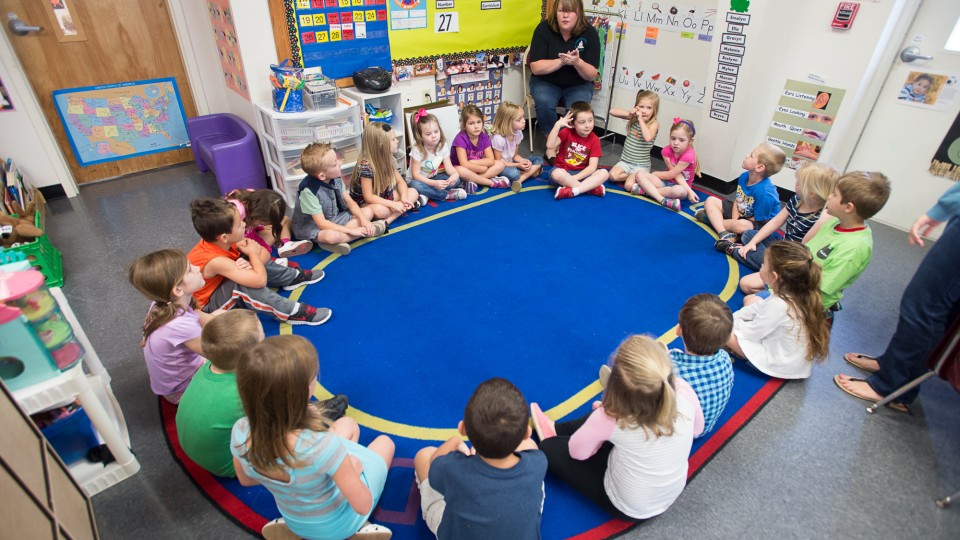Where do we go if we don't know where we stand?
- August 30, 2015
- / Shannon Nickinson
- / education

Amy Philley teaches students about planets and the solar system in her VPK class at the Gonzalez United Methodist Child Enrichment Center in Cantonment, Fl. Wednesday, April 29, 2015. (Michael Spooneybarger/ Pensacola Today)
The Studer Community Institute’s metro dashboard aims to be a roadmap to help build citizen-powered change, to make Pensacola a more vibrant community for all of her citizens.
That’s not a recipe Pensacola always has gotten right.
If we expect to build a community that brims with entrepreneurial spirit, values education, and grows middle-class jobs, we have to.
We must create a better educated workforce of people with the skills to draw new companies in and help existing businesses expand, adding jobs that pay better wages.
That matters because as the Institute’s senior fellow Rick Harper says: One of the best investments a community can make in economic development is to making sure our 5-year-olds show up to kindergarten ready and eager to learn.
And 81 percent of Santa Rosa County 5-year-olds in 2014 were kindergarten ready — well above the state average of 71 percent.
That’s something the metro dashboard tells us we should celebrate.
But in Escambia County, only 66.2 percent of children were kindergarten ready, five points below the state average.
That’s something the dashboard tells us we need to work on.
And why is that important?
Because that’s our community’s future — slipping away one 5-year-old at a time.
It matters because the gap that exists between the counties in kindergarten is the same gap that remains by the time high school graduation rolls around.
In Escambia, 66.1 percent of high schoolers graduate; in Santa Rosa 82.8 percent do.
That’s our workforce — being diminished with each student who doesn’t get a diploma.
It matters because people like 32-year-old Chastity Loveless have to hold their breath when they put their bills in one pile and their checkbook balance in another.
Before Loveless moved into a Habitat for Humanity house with her three children, they were living in a three-bedroom apartment that cost $850 a month. Utilities were another $200.
"Some months it took all of my paycheck just to make rent," she said.
Because per capita income in the Pensacola area – an inflation-adjusted measure of the average person’s buying power — was $38,165, more than $4,400 below the state average.
That’s our economy — shining less brightly than the rest of the Sunshine State.
It matters because the estimate is that half of the 305,000 people in Escambia County don’t have health insurance.
Yet 60 percent of our population is overweight or obese — and at higher risk for a host of medical problems that will shorten their lives, diminish their productivity and drain financial and health care resources for business and individuals throughout this community.
That’s our health and productivity — being drained in part by things we do to ourselves.
But that is the conversation we too often fail to have.
We could be talking about how to improve the college graduation rate, because research shows that communities with a higher percentage of residents with bachelor’s degrees or higher have higher average wages.
According to the American Community Survey, only about 15 percent of Escambia County residents have a bachelor’s degree, and 15.8 percent of Santa Rosans have one. Both counties lag behind the state average of 17.1 percent.
That’s our intellectual capital — being frittered away.
But that is not the conversation we have.
And if those aren’t the questions we ask of our elected officials, of our business and education leaders — of ourselves — aren’t we just talking to pass the time?
If we aren’t applying the lessons of success stories — inside this community and out — to the challenges of poverty, government accountability, low wages, poor educational attainment and poor health and public safety, aren’t we just paying lip service to progress?
If we want to build on the progress the Pensacola Metro area has seen in the last 10 years, we can do better.
 CivicCon launches with a look at good growth in cities
CivicCon launches with a look at good growth in cities
 Building stronger brains one baby, one parent at a time
Building stronger brains one baby, one parent at a time
 SCI debuts commercial on Early Learning City
SCI debuts commercial on Early Learning City
 Entrecon: World class speakers and an opportunity to sharpen skills
Entrecon: World class speakers and an opportunity to sharpen skills
 PYP Quality of Life survey 2017
PYP Quality of Life survey 2017
 EntreCon Pensacola 2016: A look back
EntreCon Pensacola 2016: A look back
 Leadership tip: getting better employee takeaways
Leadership tip: getting better employee takeaways
 Leadership tip: be interested instead of interesting
Leadership tip: be interested instead of interesting
 Leadership tip: delivering difficult messages
Leadership tip: delivering difficult messages
 Brain Bags boost Arc, Early Childhood Court programs
Brain Bags boost Arc, Early Childhood Court programs